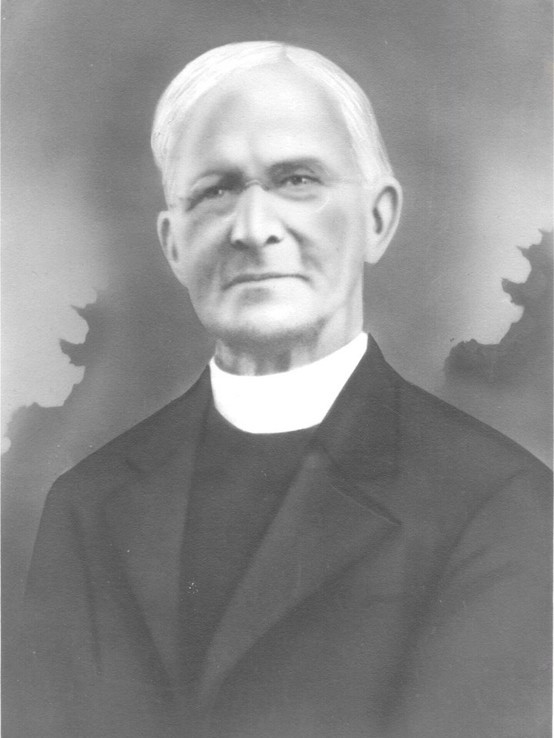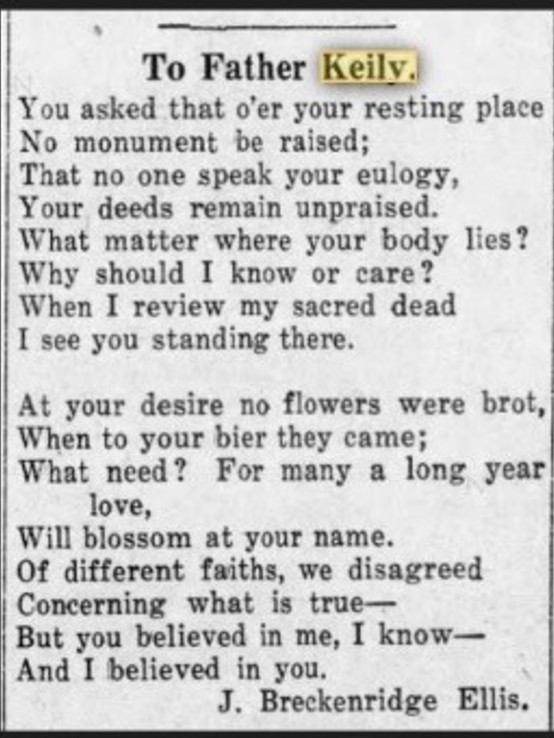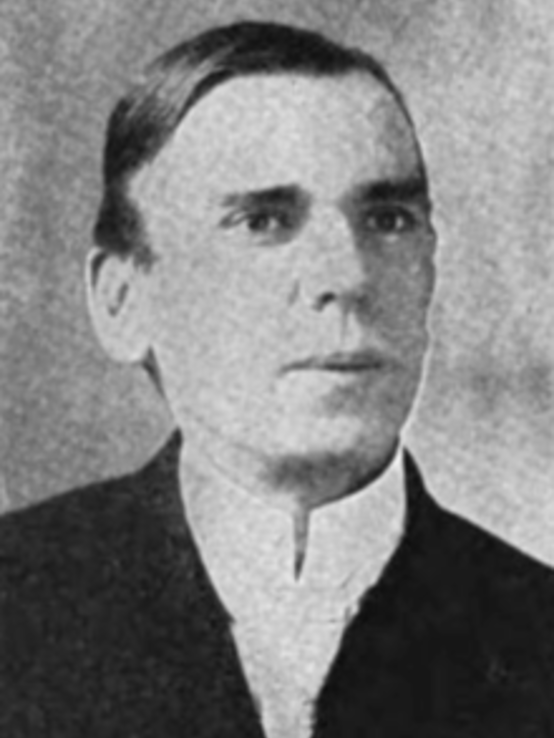Solid Rock in Shifting Sands of Time and Circumstance
St. Ann parish began in the living space of a residential home in Plattsburg, Missouri, Clinton County, in 1866 in the immediate double aftermath of the decade-long Border War between Missouri and Kansas, and the American Civil War which followed hard on its heels.
Records from the same period in Butler, Missouri, in Bates County, perfectly capture the pattern of picking up the pieces after long interruption from chaos and upheaval: In the ledger for the circuit court proceedings, the last entry is just before the infamous General Order Number 11 of August 25, 1863. A single blank page gives witness to the whirlwind which followed before new entries begin again in 1865, almost as though nothing had happened. That blank page is a chilling and intriguing place-holder for the many volumes that would be needed to record the spell-binding story which then played out.
Although Clinton County was not as adversely affected as Bates County, this same pattern of what may be dubbed “upheaval social amnesia” has proven to be very similar to the remarkably spotty history of our parish. Trying to fill in the blanks has become a cross between a labyrinth and a long treasure hunt: populations on the move, immigration, changes in American society, re-drawn diocesan territories, missionaries on the frontier spending every moment and penny on their mission, but keeping few records. Although a number of parish families have been with us for over 150 years, each of those generations often thought their stories too obvious – or too humble – to pass to the next generation; this also contributed to old documents and images disapearing down the memory hole.
The gaps in information are more than puzzling; the glimpses of life so far discovered, paint the heroic in the everyday. Everywhere, the Providence of God leaves both questions and fingerprints.
It was not long after St. Ann parish began as a “house church” served by missionary priests that the number of parishioners grew well beyond the capacity of a home’s front room. For a brief time, the congregation moved to a pre-existing building in downtown Plattsburg. Our first formal church, however, was a simple wood-frame building on 4 th and Maple streets; but was outgrown in spite of a number of expansions to the structure.
At this critical moment, the right pastor arrived to give this blooming community what it needed to become a fully established parish: Fr. Denis Keily.
Although but 29, he was ready. Having been educated in St. Patrick’s College in Carlow, Ireland, (the second-most common training ground for Irish missionaries), he was ordained there in 1878 and sent to the Archdiocese of St. Louis, Missouri, in 1879. He served in parishes there, in rural parishes in southern Missouri, and in then-twelve-year-old Annunciation Parish in the West Bottoms of Kansas City, Missouri.

St. Patrick’s College in Carlow, Ireland
Fr. Keily would never again return to his native Ireland; perhaps that his own mother was also named Ann gave him some satisfaction.
At the time, our diocese was the Diocese of St. Joseph, and it was in need of more priests. Fr. Keily answered the call in 1884, and by 1888 St. Ann Parish church stood firmly planted at 7th and Maple Streets, its steeple pointing heavenward. The cornerstone was laid in April, 1888, and the Church was completed and formally dedicated on December 18 of the same year, just in time for Christmas – a breath-taking accomplishment.
This endeavor, however, was not rushed with a view to meet mere utilitarian need: the construction of St. Ann Church was deliberate, intentional, and aligned with its nature and purpose: the trysting place of Jesus, the Bridegroom, with his Bride, the Church. Accordingly, each step of construction was treated exactly as it was – a step down the aisle to the Wedding Feast of the Lamb. This is where time and eternity meet, and they knew it.
From the beginning, when the cornerstone was laid in Spring, up to the moment it officially opened at its dedication, St. Ann parishioners initiated each step with prayers, sacrifices, and ceremonies which were noted in the local and regional newspapers.
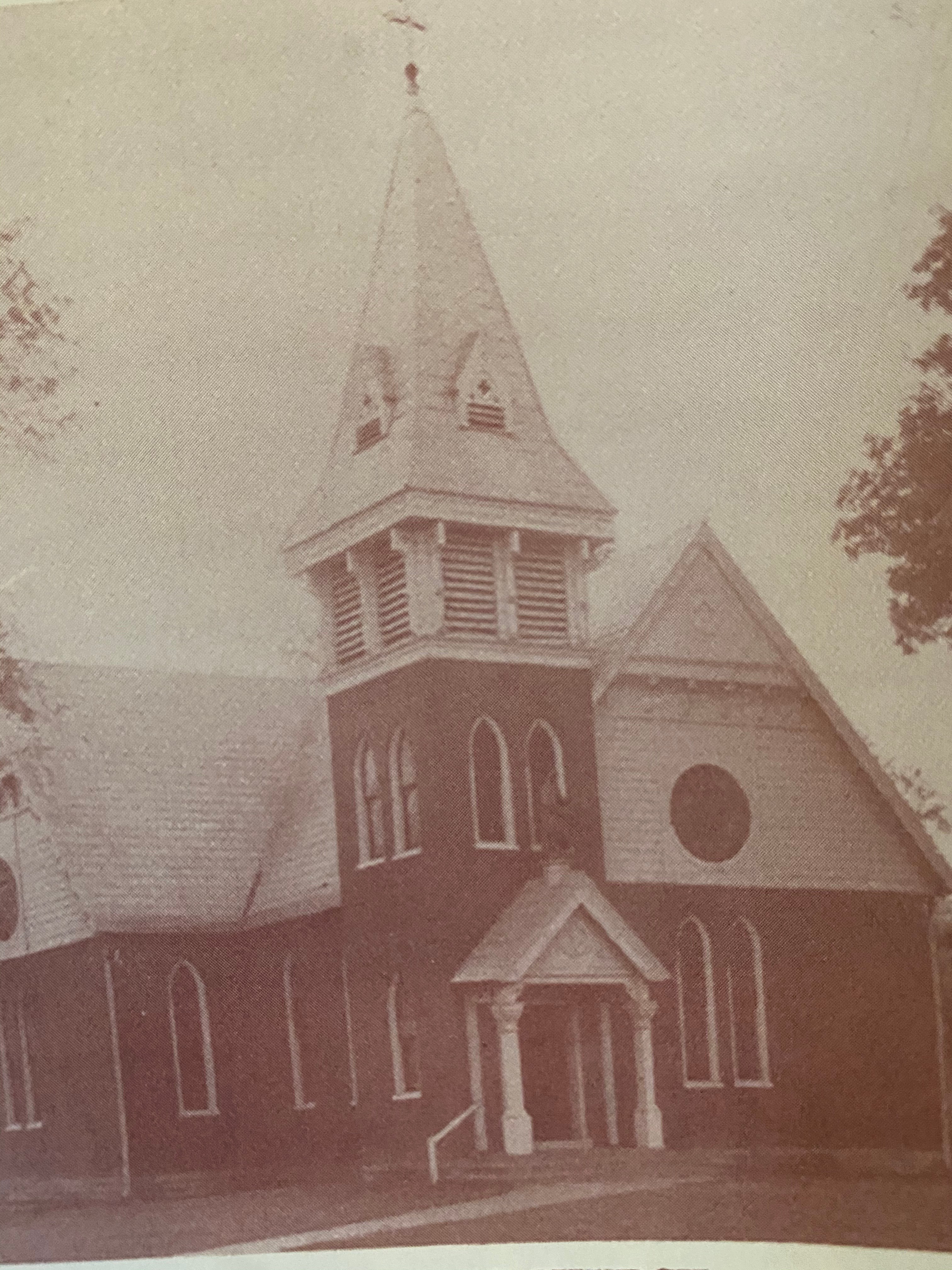
St. Ann Church -1930s
From The Kansas Catholic, Leavenworth, Kansas, 19 April, 1888:
At 10 a.m., the church societies and the clergy assembled
at the parochial house to vest and form procession. Thence they
proceeded to the church and headed by censer-bearer, which
[sic - with] smoking censer; cross-bearer between two acolytes
holding lighted candles; the children of Mary following their
banner; the Holy Family society following their banner; all
wearing white flowing veils and medals; next the Holy Name
society wearing badges; the clergy in cassock and surplice, and
the ministers of the Mass vested in rich vestments. Mass
celebrated, they went in the same order followed by the men,
then the ladies of the congregation to the site of the new
church. Assembled there, Rev. W. P. Bourke preached from a
raised platform. After the sermon, Very Rev. T. J. Downey, D.C.,
sprinkled with holy water, the place on which the altar will be
built, while the clergy and chair changed [sic – chanted] *Psalm
88 (How holy are thy Tabernacles) next followed appropriate
prayers. Psalms 126 (Unless the Lord Builds the House), 50
(Have Mercy on Me;) 86 (The Foundations). In a cavity in the
stone were enclosed a recital of the act, the date, names of
Presidents, Governor of Missouri, Mayor of Plattsburg, Pope and
Bishop of St. Joseph. Also, coins, newspapers, the Catholic
Review, the Catholic American and the Democrat.
(* Psalms in the Bible are numbered somewhat differently today)
And that was simply to lay the cornerstone of the foundation.
On opening day in December, as it was being dedicated, it was momentarily bare of all but the essentials; but everything from the steeple to the ground was paid for – all $6,000 of it.
The altar had been donated by the ladies of the church – and the beautification of the church was only just beginning.
Parishioners wanted to make it clear to all the town what intimate presence Our Lord had among them, and they did so with wedding gifts of great beauty for all generations to enjoy at the Wedding Feast: when completed, St. Ann would become one of the most highly decorated parish churches, especially for its size and rural setting, west of the Mississippi.
All of this came to pass during times of upheaval, change, revolution, poverty, uncertainty and tumult. They knew that while the needle on a compass need move, the compass must stay fast. The faith, and the parish which fed and guided it, was that compass.
And it showed.
A baptismal font was lovingly carved from local wood; a life-size crucifix and statues of the Sacred Heart of Jesus, Blessed Mother, and St. Ann stood ready to welcome; large, bas-relief stations of the cross from Montreal were purchased and installed.
In 1890, fresco paintings were applied to the walls and ceiling to depict the span of salvation history.
Regional newspapers took great pains to paint a word-picture of the splendor of St. Ann’s for readers:
[Excerpt, The Kansas Catholic, Leavenworth, Kansas, 06 February, 1890]
The following Spring of 1891, stenciled glass windows were installed, just in time for Easter.
St. Ann Parish Makes its Mark
As the century turned from the nineteenth to the twentieth, St. Ann parish became a center for culture for the whole community.
Plattsburg at the time had a number of schools, including a college-prep high school called a "college." St. Ann stepped up to supply the Catholic school which the city lacked. St. Brendan’s School, a brick building which once sat on what is now the northwest corner of our current parking lot, operated from 1896 – 1939.
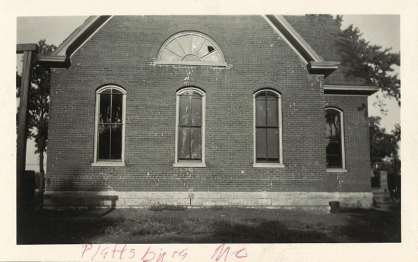
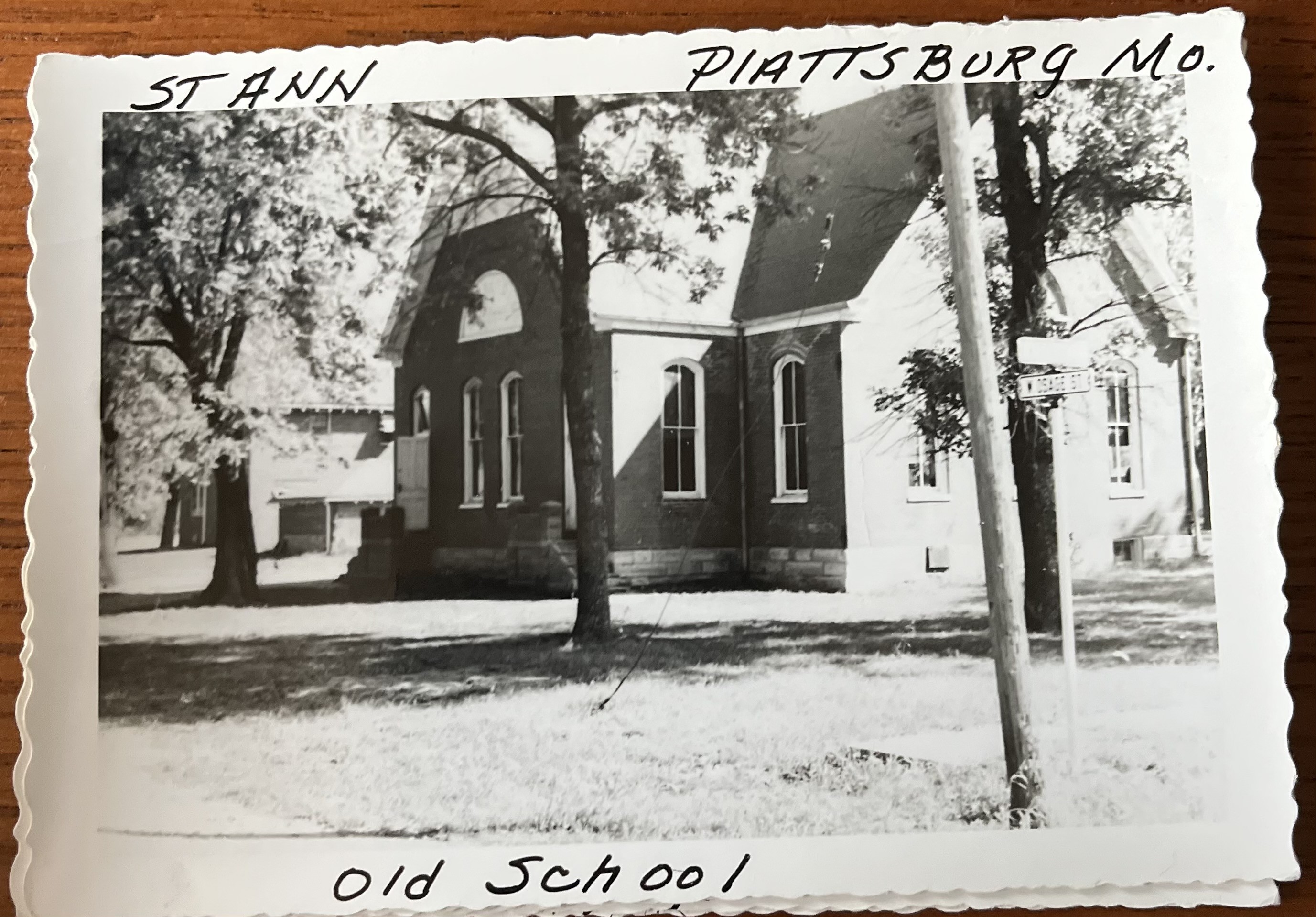
St. Brendan School
Nuns at St. Ann
Three orders of nuns taught a wide variety of subjects there, including college prep courses:
1896 - 1901: Sisters of St. Joseph, Wichita, Kansas
1901 – 1929: Sisters of the Precious Blood, Red Bud, Illinois
1929 – 1939: Sisters of St. Francis, Clinton, Iowa
These religious orders continue work today, yet much of the history of their work here has been lost in the nearly constant movement of the period, reorganization of ever-growing dioceses, and all too common fires which eradicated decades of archives of at least one order --another blank page in the story.
Aside from school activities, book clubs, social enrichment gatherings, theater productions and retreats filled many days of the year for people of all ages.
St. Ann Church was also a center for music, especially beginning in 1902, with the installation of a J.G. Pfeffer pipe organ donated in the memory of parish family matriarch, Margaret Downey. Local papers and parish family recollections are rich with memories of concerts and a stellar music program.
A Time of Testing
The first hard shock faced by the parish and community at large came in 1929, with two tragedies in rapid succession: Fr. Keily died in a brutal, one-car accident in May. By this time, he had been a virtual fixture in the town. He was mourned all across the region; in Plattsburg, all businesses and schools close to recognize his passing.
Local celebrity author, J. Breckenridge Ellis, (https://en.wikipedia.org/wiki/J._Breckenridge_Ellis) had been an occasional intellectual sparring partner of Fr. Keily. In the good priest's honor, he penned a poem in the special edition of the local newspaper:
Ironically, the parish finally managed to build its present rectory that year. Until then, Fr. Keily had slept in the church itself --for a time in the bell tower - in order that the lone residence on the campus would be for the teaching sisters.
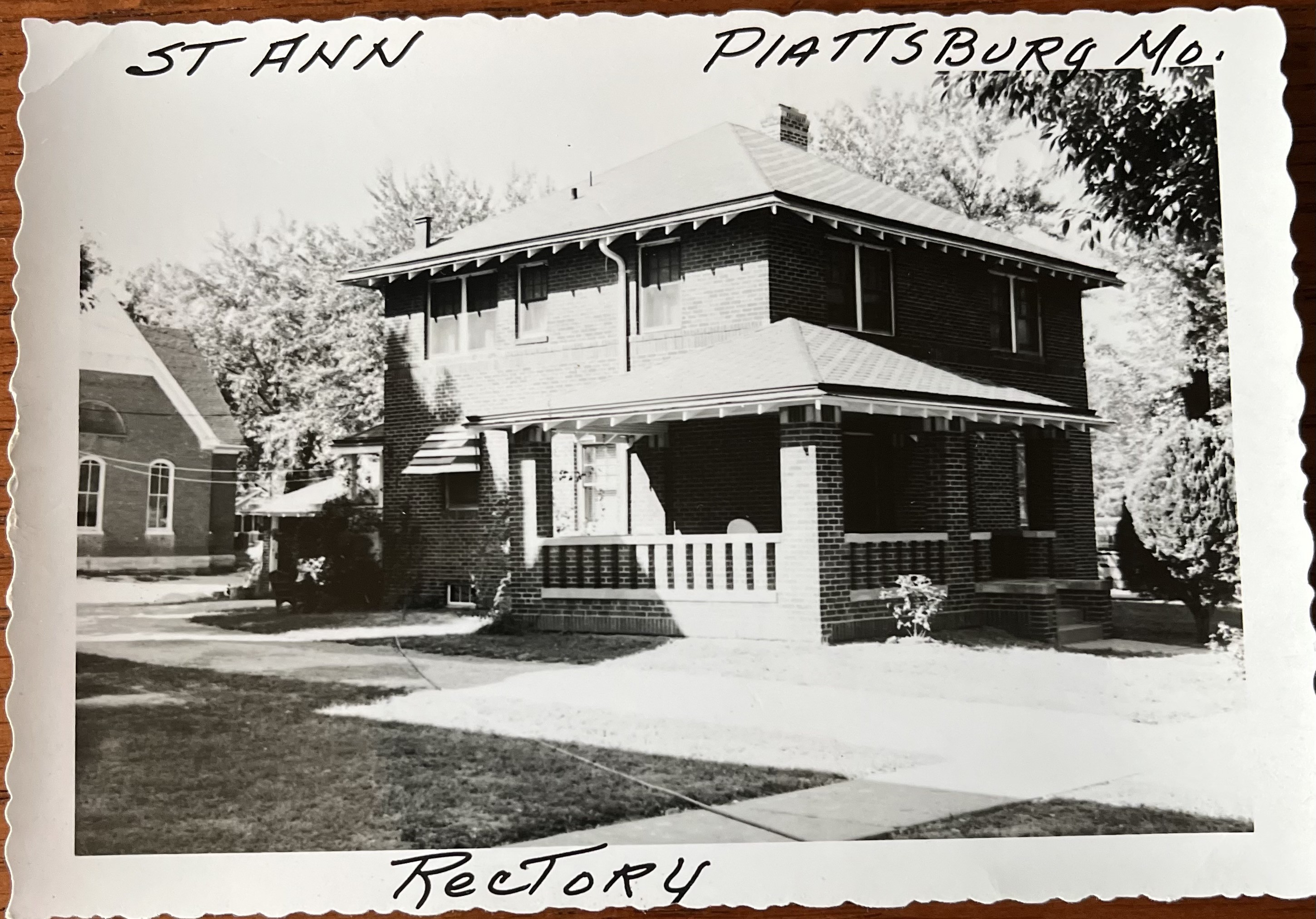
The second shock came with the onset of the Great Depression by the end of that October. It marked a steep decline in both fortune and, for many, faith.
St. Brendan School was closed by 1939; with the movement of much of the impoverished population to the cities with the Great Depression, the town began to empty of children.
More Blank Pages --But the Ultimate Rescue
By as early as 1932, between the rush of change and the absence of Fr. Keily, more "blank pages" were inserted between the parish as it was established and the years following. Then came the Second World War. From this point forward, as with the end of the Civil War, "upheaval social amnesia" struck again.
From the 1930s until recently, the parish church underwent a series of renovations which effectively erased or buried traces of its past: the pipe organ was dismantled and disappeared. No one knows where most of the statues went. The fresco paintings were covered with paint and tin. Even the memory of the glorious, epic stations of the cross can be found only in newspaper accounts.
By the 1960s, the original altar was removed and the church carpeted.
Between the 1960s and the end of the 1990s, the parishioners of the period managed perhaps one of the most difficult and important feats since our founding: It was during this time that the parish came close to being closed and was practically forgotten by all but the locals. Our parish family from this period took the church into their own hands and kept it alive for us to enjoy and restore today.
The story of the generations which made these changes is also very spotty and we are hungry to know more.
Fr. Keily's Enduring Presence
For however many or few generations have passed in our last century and a half, the Wedding Feast celebrated here is timeless, not time-bound. It is the reason we are here at all and why the church is built and furnished as it is.
And parishes forever include all its parishioners, from its beginning until the end of time. Catholics call this the Communion of Saints; the great intellectual, G.K. Chesterton, called it "the democracy of the dead," to include the dead, the living and those yet to be. St. Ann, in short, is the common family name of all its members, and the parish church is our family inheritance.
In recent months, this has become manifest in providential ways.
Lately, as if out of nowhere, more and more of what was lost has been returning, like the people Israel coming home from the Babylonian Exile.
In 2019-2020, a time of worldwide chaos, the earnest treasure hunt for our lost past began with the discovery of the strange problem that we had virtually no real archival history as a parish: no piles of photos of the old interior of the church, of activities, or community events. It was if today's parishioners landed here from the moon with amnesia.
Months of searches in articles and archives strangely found no trace of a community which had been here for a century and a half. Then one day, both the parish priest and a parish historian did the same thing, each without the other realizing it: they both turned to Fr. Keily for help --one with prayer, one with a change in research focus.
Immediately, with a switch to a search for Fr. Keily, rather than for St. Ann's, there appeared a newspaper photo from 1907 depicting the original art and statuary in the church. It was as if a door had opened to a secret room. The parish historian sent a copy of the photo to the parish priest, and the gateway to adventure began in earnest.
Intriguing stories of the heroism and sacrifice of Fr. Keily began to surface: the intricacies of the Irish American subculture, a world revolving around train schedules, revolutions, and fights with the KKK. From little nooks and crannies, long lost stories of parishioners and a vital community began to bloom, like flowers in a rain after a long drought.
But there was far more than the recovery of old records. The church building itself began to take on a new life.
At about the same time as the discovery of the photo, local carpenters and artists skilled in the historical stencil work of the late 19th century renovated the office.
In 2020, we received an especially appropriate donation: 19th century ceiling lights, much like the ones original to St. Ann. The story twist: they had come from Annunciation Parish in Kansas City, closed now for 30 years -- previously under the care of none other than our own Fr. Denis Keily!
So began a virtual parade of new parishioners and supporters joining the same procession begun so long ago in 1888. Our parish membership began to grow, inspired by the equally growing beauty of the church which more easily raised their hearts and minds to God.
Near-duplicate statues of the Sacred Heart, Blessed Virgin, and adoring angels from the same era have been found and now sit, fully restored, where they were originally intended to be. That they so resemble the originals -- and were discovered nearly all at once --is uncanny.
A life-size crucifix carved to resemble the one in the 1907 photo now sits where stood the original; so, too, have the altar, altar rail, and elaborate stands for the statuary been re-created. The narthex is being reworked to its former size. And statues of angels once more adore in the sanctuary.
Ever more aware and energized by the obvious movement of renewal, parishioners generously paid for the restoration of early-twentieth-century plaster DePrato Stations of the Cross --very similar to the originals. And to top it off, the elaborate, wooden, gothic confessional original to St. Francis Xavier in St. Joseph, was rescued, donated by the Pro-Life Shrine of St. Joseph, restored, re-worked and installed by local carpenters.
In the meantime, basic maintenance and housekeeping, long-delayed through harder times, was provided by donations in work and finance. New HVAC, brick-tuckpointing, and a new synthetic slate roof to resemble the original --but more durable and maintenance-friendly --now work to protect our home.
The steeple comes next, adorned with a replica of the original, large copper cross.
A Catechism in Structure and Image
In the middle of the flurry of rejuvenation came signs that restoration was meant to continue to full completion: In 2021, a portion of the tin ceiling was professionally removed temporarily and the original ceiling frescoes were discovered beneath. What had been only words in newspaper articles came to life.
As donations of period-appropriate antiques and replica-work began to pile up, this --we thought --was the final sign to move forward with the largest, most complex and expensive aspect of restoration: re-painting the walls and ceiling.
The parish partnered with Conrad Schmidt Studios of Madison, Wisconsin, a proven professional renovation company with a long track record of restoring historic Catholic churches in our diocese and elsewhere.
To be clear, there is no way to bring the original wall art "back." Simply removing the newer paint would not reveal the frescoes beneath: the newer paint had destroyed them. Wood lathe which holds up the tin ceiling riddled the original with holes, and the original lime plaster. But now we can see the original images, directly or in old photos. No longer must we merely speculate from descriptions. Now we can re-establish on wall and ceiling the lost images in newer, more protective and maintenance-friendly materials.
More long-lasting paint by professionals make both a restoration and an investment to last for years to come.
Working with Conrad Schmitt Studios and using old photos and our knowledge of the architectural and artistic style of the church, the Studio produced a rendering which captures St. Ann's Nathaniel Westlake English Gothic style perfectly.
A plan was made for a professional fund-raising campaign and a carefully mapped completion of the renovation is underway.
God Always Supplies More Thank You Can Think to Ask
As if to confirm this, yet another providential discovery was made: the organ. And not just any organ. In a Nebraska church literally on the verge of collapse stood a J.G. Pfeffer organ --identical in type, model, size and manufacture to the one originally at St. Ann --made only one year before our own.
In 2022, the Bedient Organ Company of Lincoln, Nebraska, contacted St. Ann with an incredible offer from a Lutheran church which had been closed for over 30 years. It had a 1901 Pfeffer organ in danger of being demolished. As miraculously as this organ had appeared and been offered, funds were quickly raised for its rescue. Bedient has confirmed that it is fully capable of being returned to its former glory.
J.G. Pfeffer, a German Catholic organ builder, built fine mechanical action organs in the nineteenth and early twentieth centuries. Bedient Organ Company is the inheritor of the Pfeffer tradition of mechanical organ restoration. They have verified that this newly-rescued organ is the same size to fit in the original location here at St. Ann's. They expertly moved it to their shop, where it awaits restoration.
As a testimony to the fact that such organs were meant to last for centuries, and in spite of the deplorable conditions in which it was found, it still played! The Pfeffer organ original to St. Ann, still in its prime, was removed in 1948, and likely thrown away, after having been played for only 46 years. That Margaret Downey memorial Organ was the center of a number of concerts, noted in local papers.
What Next?
Faith is not a passive thing: it requires a response, and the parish and its supporters have been responding, often from unexpected quarters. All of our history has been --and remains --a treasure hunt across many lifetimes.
This renovation is not the personal project or taste of a special group or pastor or individual. It is simply allowing the church structure to be what it is and in a form that can be passed through generations. It is us, but bigger than us, because it is, above all, for and with God.
In this age of so much disagreement and argument over what is right or true, there remains one avenue to both truth and goodness which does not require constant, bitter argument or definition: beauty.
Beauty is encountered, not explained. It is the small, still voice in all the thunder and earthquake. It is where conversion of heart, mind, and soul can simply be.
Churches in the Gothic style were expressly meant to be a space to enter into beauty and sacredness itself, not merely a meeting hall to discuss or think of such things.
That is what we seek to complete.
We can see the finish line.
The initiative from so many, living and deceased, is clear.
We have begun the process of the final stages of restoration, and now you have the opportunity to join this procession.
As in the equally chaotic time in which St. Ann's was built, this endeavor is not a mere project or campaign; it is an act of faith requiring the grace of God. And, as we have seen in spectacular form over the last few years, God works through everyday people, as he did with the Apostles.
We hope you will join in this pilgrimage and multi-generational act of trust to finish the last few steps which remain to bring this much-needed sanctuary of the soul back -and fill in that page left tantalizingly blank so long ago.




